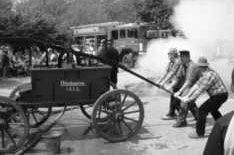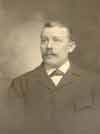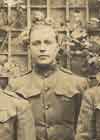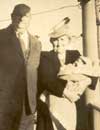Familienforschung / Frankenhäuser Familien |
Hermann Wilhelm Emil SUPHAN leaves Frankenhausen.
The emigrant and his family
(illustrated with two tables at the bottom
of this article)
From Frankenhausen to Manhattan
In 1882 twenty three year old Hermann Wilhelm Emil Suphan and his wife
who was two years younger emigrated from Thuringian Frankenhausen to New
York. Why did the young couple leave their home country and their family
for an unknown future full of risks?
|
At that time German emigration to America had already
passed its peak. Religious and political reasons for emigration
may be eliminated as well as simple poverty. Who at that time like
the Suphans decided to emigrate although living in intact social
relations had to have other reasons. Such were certainly the brutal
changes that they now were confronted with. What could they loose?
For generations sons had decided to follow their father's profession.
Butcher, baker, cloth maker, soap producer, smith and others had
continued to be linked with certain families. But this traditional
pattern was not effective anymore. The former guild laws (Zunftzwang)
with their forced regulations of the traditional trades had been
changed for the freedom to choose the job you liked (Gewerbefreiheit).
This was a chance for people from outside the guilds, but a depressing
threat for those from inside who now lost protection. It was not
granted anymore, that the profession of the forefathers could nourish
their families further on. - Also the smith's profession had lost
exclusivity. Weapons could be produced industrially now. The importance
of horses had continuously diminished - beginning 1835 - with new
mobility provided as railroads extended. Those who emigrated at
that time - in my opinion - mainly were afraid of expected economic
and consequently social decline. Avoiding this social decline would
be easier in the prospering new states of America. Such was their
hope. |
At that time also the inhabitants of Frankenhausen were confronted with
changes. As to communication and information the new development even
offered advantage. Due to printing newspapers and growing public reading
the Frankenhäuser Intelligenzblatt had started being published since the
last quarter of the 18th century. Emigration was not only discussed within
this media but mainly by a specialized emigration newspaper, published
also in Frankenhausen. Individual decisions for emigration may have been
accelerated by letters of relatives and friends who reported about their
success in the New World.
The immigrant Suphan did not find gold mines in the new world but solid
work instead. So he managed to put his roots deeply into the earth of
his new home country.
But what had he left behind? How had his family been living within his
earlier home country?
Family Suphan from Frankenhausen
My actual research for the Suphan family reaches back to the first half
of 18th century. At that time Johann Caspar Suphahn
[1] was mentioned in the Church book of Frankenhausen in Thuringia.
As his son and grandson became smiths it is to be supposed that also he
had practised that profession.
His son Andreas Gottfried (1754-1832) is titled as Huf- und Waffenschmied
(horseshoe and weapon). From his marriage with Amalia Dorothea Henriette
Lange six children are proved, four girls and two boys.
His oldest daughter loved a musician and bore her son outside marriage.
But the church book tells us "Der Vater soll nach Angabe der Wöchnerin,
der bisher beym Stadtmusico Löffer in der Lehre gestandene nunmehrige
Musicantengeselle, Namens Aßmann gebürtig von Ringleben seyn."
[2]
This is reported within the church book at the place where generally the
father's name is expected. But they seem to have married some time later.
This can be derived from other written lines in the church book ten years
later. When in 1816 she became godmother at the birth of her brother's
son she is called "uxor des Musikus Herrn Johann Christoph Aßmann"
(wife of the musician).
|
The reason of her complicated liaison may have been, that marriage generally was socially accepted not before you had a constant job like a trade's master. But Aßmann was apprentice at that time. |
While almost all of the numerous children of his younger son, Johann
Günther Wilhelm Suphan (1792-1867), died shortly after birth
[3] , those of his older
son Anton August Carl (1785-1850) reached high and very high age.
Church books always call the latter one "the smith".
One of the most damaging fires in the town's history threatened Frankenhausen
on September 15, 1833. When at the same time a storm arose the fire rapidly
grasped wide areas of the town. The fire destroyed 168 houses a lot of
barns and sheds and as the most severe loss the historical town hall from
1444. Total loss was estimated up to 250.000 Taler, a very huge amount
at those times. - Only three months before this terrible event when in
order to improve effectiveness of fire fighting a new fire constitution
had been decided on, the persons responsible for the fire hose Nr. one
were mentioned. [4]
They were Master locksmith Koch and Master blacksmith Suphan Jr.
This must have been "the smith" Anton August CarlSuphan. The
locksmith
 Koch might have been
a brother-in-law of his since Anton's wife's maiden name was Koch. So
it may be supposed, that both fought together at fire hose Nr. one. This
fact has a special importance for his American great-great-great-grandson
William H. Suphan. It seems that also after immigration fire fighting
continued as a tradition within the family. We will later return to this
item.
Koch might have been
a brother-in-law of his since Anton's wife's maiden name was Koch. So
it may be supposed, that both fought together at fire hose Nr. one. This
fact has a special importance for his American great-great-great-grandson
William H. Suphan. It seems that also after immigration fire fighting
continued as a tradition within the family. We will later return to this
item.
Friedrich Anton August (*1816), son of the fire fighter, did not
continue with the tradition of a smith but became a shoemaker.
As already seen above, his son Herrmann Wilhelm Emil Suphan (1859-1951)
together with his young wife, Ida Scheffler, emigrated to America in 1882.
They belonged to those immigrants who did not continue their journey into
the country but stayed in Manhattan, the harbour of immigration. It was
not before 1898 that the independent Manhattan together with Brooklyn,
Queens, The Bronx and Staten Island united to the one New York.
Suphans in the United States
| Thanks to the fact, that a great grandson of our immigrants from Frankenhausen looked at my website and discovered a Suphan having been member of the Frankenhausen Fire Brigade of 1832, also of having fought the big, destructive firestorm Frankenhausen suffered from in February 1833, and also thanks to his helpfully remembered details of the family history I am able to present how the immigrants from Frankenhausen and their children integrated themselves into American life, i.e. how they became Americans. |
As already mentioned, Hermann Wilhelm E. Suphan (1859-1951) and
his young wife Ida,  born Scheffler, came to
New York in 1882. They originally settled in Manhattan. Their first son
William Herman was born here in 1884. Two further sons, Frank L. (1888)
and Herman Emil (1995) followed. About 1890 the Suphans purchased real
estate in Brooklyn [5] .
Herrmann - still German spelling - is listed in the 1900 Census
[6] as a cigar maker and the family name was listed as Subhahn. Later
on it is again Suphan. So the irritation, already caused by different
spelling of the name in Frankenhausen, continued in the U.S.
born Scheffler, came to
New York in 1882. They originally settled in Manhattan. Their first son
William Herman was born here in 1884. Two further sons, Frank L. (1888)
and Herman Emil (1995) followed. About 1890 the Suphans purchased real
estate in Brooklyn [5] .
Herrmann - still German spelling - is listed in the 1900 Census
[6] as a cigar maker and the family name was listed as Subhahn. Later
on it is again Suphan. So the irritation, already caused by different
spelling of the name in Frankenhausen, continued in the U.S.
|
We unfortunately do not know whether he practised other professions beside the cigar maker. Sales of tobacco and cigars must have been immense at those pre-cigarette times. Large factories had developed, but had been exceptional at the middle of the century. Robert Ernst says: "In 1855 the Germans accounted for four fifths of all the foreign born tobacconists. In the tobacco industry […] no sharp differentiation existed between employer and employee: if skilled, an employee might become an artisan-shopkeeper, combining manufacture with sale." [7] But this refers to half a century ago. So his exact doing remains in darkness to us. |
An interesting aspect to his life was that he was very active in a German-American social group called the Legion of Honor. The Brooklyn Daily Eagle newspaper lists several social events with him acting at one point as the "Dictator" of one of the lodges.
|
There were several lodges in the New York City area
apparently. It was very common for people who came from one area
in Europe to congregate together due to mutual language, customs,
religion, etc. Especially Germans were famous for meeting in the
"Vereine". Those institutions flourished in Germany during
the first half of the 19th century. Originally founded to exercise
hobby activities like singing, sports etc. they soon became places,
where discussion on political affairs was possible without hurting
the absence from political action which absolute rulers in Germany
expected from the under and middle classes at that time. In their
new home country German immigrants rapidly organized such institutions
as area for social life. Especially within the lodges they also
organized mutual help for those who needed support. - Often times
their children, the first generation born here, would somewhat rebel
against this tradition and assimilation often took place by intermarriage.
|
The Suphans are a good example of this pattern of assimilation. Robert
Jourdan Suphan Jr. remembers the following. Although the immigrant Hermann
Wilhelm E. and his family "lived in essentially a German enclave
in Brooklyn" - where they had bought real estate - "they would
not allow their friends to come over until the three boys (William, Herman
and Frank) were in bed so that the children would not hear German being
spoken at home. They were determined that the three boys would only learn
English and be proper Americans." The immigrants' son, William Herman
(see below), marrying out of the German-American community accelerated
assimilation by this decision.
Back to Herrmann Wilhelm E., who meanwhile had become Herman William E.
Suphan. "He was an excellent long-range shot and entered contests
annually and always placed somewhere among the top three contenders."
There still exists a trophy "for winning a match with a rifle near
what is now Coney Island." He certainly had no military obsession,
but the joy and capability of shooting may be a heritage of the German
custom of Schützenvereine (i.e. shooter association), where shooting
was practised as a sport and the winner of annual contest was elected
"Schützenkönig", king of shooters.
A funny family story is that when radio was new he was asked to listen
to this new machine. The family set up the radio and violin music was
the first thing that played. He looked across the room very confused and
then smiled and said, "Ah, shut zee veendow!" ("Shut the
window" as his German accent sounded.) He thought someone outside
playing a violin was fooling him.
 Continuing the idea of becoming American let me add another remark. For
most German immigrants and their descendents World War I mostly meant
a radical cut from their historical roots towards being Americans. At
least one Suphan, i.e. Herman Ernst, served in the Army during that war.
There is a photo of his wearing army uniform in France.
Continuing the idea of becoming American let me add another remark. For
most German immigrants and their descendents World War I mostly meant
a radical cut from their historical roots towards being Americans. At
least one Suphan, i.e. Herman Ernst, served in the Army during that war.
There is a photo of his wearing army uniform in France.
The young William Herman (1884-1954) joined the
Fire Department of New York at the age of twenty-two in 1906. He was also
listed as a "driver" as his occupation, which at that time would
have meant a driver of horses. The Fire Department did not go to gasoline
engine vehicles for more than ten years later. - He married Angeline
Maria Vincent [1881-1973].  She was descended from at least two old lines of New York families, the
Vincents and the Bogarts. Her father was Dutch with added Irish roots,
her Mother Scottish. They had two children. The Irish influence belonged
to her grandmother, a McCarthy who had come over from Ireland, County
Cork - Bantry Bay area. She had come to the Vincents as an indentured
servant, meaning that she had to repay the cost of coming over by agreeing
to work for a period of time. She then married the son of the family,
Abram Vincent.
She was descended from at least two old lines of New York families, the
Vincents and the Bogarts. Her father was Dutch with added Irish roots,
her Mother Scottish. They had two children. The Irish influence belonged
to her grandmother, a McCarthy who had come over from Ireland, County
Cork - Bantry Bay area. She had come to the Vincents as an indentured
servant, meaning that she had to repay the cost of coming over by agreeing
to work for a period of time. She then married the son of the family,
Abram Vincent.
William Herman retired from the Fire Department and passed away at age
70 only a couple of years after his father died. His wife Angeline Maria
lived to be 91.
They had two children, a daughter named Eleanor Ida Suphan
and a son named William Herman Suphan, Jr. (1909-1988). He worked
in several early jobs with his last job before joining the fire department
being a plumber.  e
served in the Fire Department for 20 years, being interrupted for two
years (1944-46) for service in the U.S. Navy as a volunteer. He had served
on fireboats in the New York harbour and had knowledge of fighting fires
on boats. So he was prepared to serve as an instructor in fighting fires
on boats. He later returned and served out his years in the Fire Department,
including serving in the same fire station (Ladder Company 147) that his
father had served. Both served as Tillerman, steering the back end of
a long ladder truck.
e
served in the Fire Department for 20 years, being interrupted for two
years (1944-46) for service in the U.S. Navy as a volunteer. He had served
on fireboats in the New York harbour and had knowledge of fighting fires
on boats. So he was prepared to serve as an instructor in fighting fires
on boats. He later returned and served out his years in the Fire Department,
including serving in the same fire station (Ladder Company 147) that his
father had served. Both served as Tillerman, steering the back end of
a long ladder truck.
|
The generally quite normal activity of fire fighting with the famous FDNY signifies something special in the context of this family history. So in a certain manner it seems astonishing that two men, father and son, of the first American Suphan generations were occupied professionally with the same activity that years ago their grandfather and great-grandfather had been obliged to do as a citizen of Frankenhausen defending his home town from the terrible fire storm of 1833. |
When he was stationed in Memphis, Tennessee William Herman Jr. met and
married Ruth Mae Woodward [1912-1972]. She was from Arkansas and
was working in an aircraft factory when they met. She was one of three
children and was English and Dutch by heritage. They had two children.
Their first son inherited his grandfather's given name William Herman,
becoming William Herman, III. The second son is Charles Vincent Suphan.
Their children may continue the Suphan story in the U.S. that had begun
more than a century ago with the immigration of German Wilhelm Herrmann.
The foregoing represents some of the personal aspects of the Suphan family
over the years from when they left Germany. It is similar to the experiences
of many other Germans who came over to the U.S. What made the story so
attractive for me was not only the special circumstance of descent from
Frankenhausen, but also the possibility to have data and facts for one
and the same family over such a long period on both sides of the Atlantic.
The idea of "melting pot"
We all know the almost exaggeratingly used term of America being a melting
pot of people from different nations. The family history of the American
Suphans is the best example for this idea always being a fact. The history
just written down of course emphasized on the German branch, what the
name's origin and continuous masculine descent justified. But Angeline
Maria Vincent added Dutch, Irish and Scottish blood to the main artery
from German Thuringia. The ultimate proof that the process of intercultural
transfusion does not stop is the fact that the couple's grandson actually
linked Hawaiian-Portuguese-Slovakian origins to the family.
©Peter Teuthorn and William H. Suphan
This essay was written by Peter Teuthorn. But it would not have been realised without having met William H. Suphan by Internet communication and without his valuable knowledge and help. While Peter researched most of the family's history in Frankenhausen and gave remarks of general history, William added all the details of the family history in the U.S. and also had a look through Peter´s English version.
Munich/Bavaria and Scottsdale/Arizona, March 27, 2005
(completed September 6, 2005)
Tables
This article is illustrated by two sorts of tables, which were done with
the genealogical software GFAhnen 5.2. One is an ancestors'
table tracing back the ascendance of William Herman Suphan Jr. following
the Kekoulé system. A subtable
starts with Hermann Wilhelm E., the immigrant. Another one shows all known
descendance from the oldest Suphan ancestor
who up to now was found in Frankenhausen. But living persons are suppressed.
![]()
Corresponding links:
Feuerlöschgeräte
in der ersten Hälfte des 19. Jahrhunderts - Stadtbrand
Frankenhausen
[1] Already with his son writing changes to Suphan. Nevertheless at the beginning of 19th century again alternatives like Suphahn and Subhahn are to be found for one and the same family.
[2] ThStA Rudolstadt, Kirchenbücher Frankenhausen, Film 2015. Translation: "The pregnant woman said, that the father be the musician named Assmann from the village of Ringleben, who shortly had finished his apprenticeship with the town's musician Löffer."
[3] A genetic defect may be supposed.
[4] Görmar, Gerhard: Die Frankenhäuser Feuer-Anstalt von 1832, Leipzig 1999/2003.
[5]
New York City now is made up of 5 areas and Manhattan and Brooklyn are
2 of those 5. Before 1898 they were separate cities.
[6] The United States takes a census of the population every ten years, however the 1890 Census was destroyed by fire.
[7] Ernst, Robert: Immigrant Life in New York City, 1825-1863, New York 1979, p. 91.